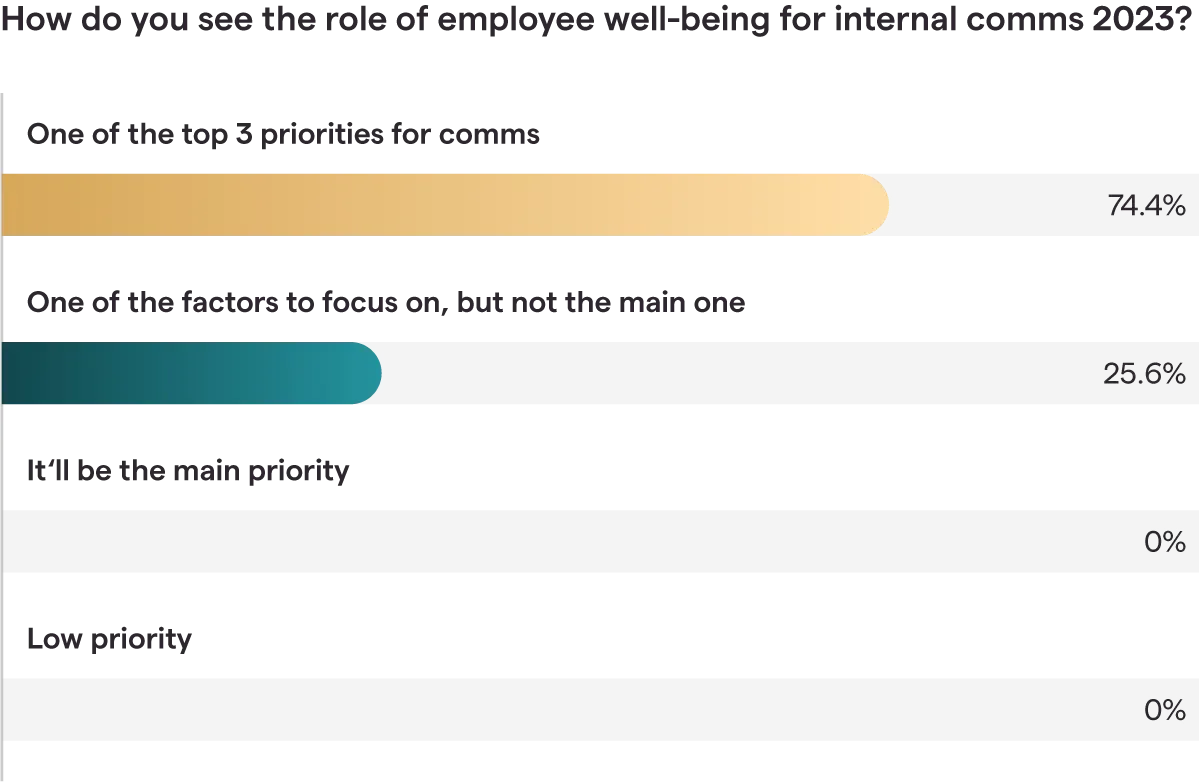Internal Communication Trends in 2023

What’s in this report
- Tracking internal communication trends
- Enhancing employee wellbeing
- Managing change
- Driving employee engagement
- Building leadership skills
- Navigating economic impacts
Share
1. Tracking internal communication trends
If there has been a silver lining to the global pandemic of the past few years, it’s that internal communications became an absolutely crucial function in nearly every organization around the world. Senior executives came to rely on their IC teams to keep in touch with their workforces at a time when nearly every workplace went virtual.
When asked to identify what trends were likely to continue to impact the IC function through 2023 and beyond, the thought leaders put two related topics at the very top of their lists:
- Increased concern for the individual employee experience
- Improved hybrid work models
These two trends will help IC professionals focus on creating the new internal communications environment for the future.

2. Enhancing employee wellbeing, near and far
Employees have been through a lot during the past few years. And for far too long, employers haven’t paid attention to their people who show up day-in and day-out. It’s time to make sure that current employees’ physical and mental needs are being met, that they are receiving recognition and praise for their efforts, and that they are being compensated fairly. Where that’s not happening, employees are packing up and leaving in droves as part of the “great resignation” or disengaging from work through what’s being called “quiet quitting.”
The information needs of the veteran employees who have survived a rough couple of years are radically different from the needs of tomorrow’s new hires. The communication that you’ll be crafting for employees who are returning to downtown offices will need to be re-imagined for employees who are choosing to work remotely.

The bottom line:
Communicators will need to tune their IC programs to meet the varying information needs of their employee audiences. That’s plural: audiences. The future is going to require moving away from one-size-fits-all IC channels and messages and moving toward focused communication efforts for segments of employees. IC professionals will need to embrace decentralized communication models that are receiver-centric rather than sender-driven.
Moreover, employees themselves will exert more control over which messages they need to see every day to be effective in their jobs. A nurse in a hospital’s neo-natal department will need radically different corporate communications – content and channels – than a pharmacist working just two floors away in the same facility. They’ve always had the capability by simply deleting or ignoring messages that are irrelevant to them. IC professionals will build models in the future that allow employees to subscribe to the information they really want and need.
3. Managing change
For far too long, IC professionals were charged with merely reporting about change efforts underway in their organizations – anything from the launch of a new payroll system to a corporate restructuring. And often those communication efforts were last-minute, ill-considered or created by people who are not communicators. They’re written to please the leaders implementing the change rather than focusing on the information needs of the employees who are affected by the change.
Today’s communicators are no longer reporters working from the sidelines. They’re active participants in effecting change by baking effective communications into every change-management program from the start. They’re helping drive change instead of merely describing its progress.
71.8% agree that change management and change communication will play a significant role in communications strategy in 2023.
Internal comms thought leaders told us that the most effective change-management communication involves everyone from the senior-most leader in the organization to individual supervisors – not merely project team leaders. While project leaders have high credibility, they often are unable to see change through the eyes of the employees who are most directly impacted. That’s why they must partner with IC pros in the future.
4. Driving employee engagement
Can you prove to your senior management team that the internal communications function makes a difference? If not, now is the time to start. Research has proven that effective internal communications can motivate 85 percent of employees to be more engaged in the workplace.
More than 43% of those surveyed said that there’ll be a shift towards more engagement-oriented metrics in 2023.
Do you ask employees questions focused on engagement in your organization’s annual or quarterly survey? Or in more-spontaneous pulse surveys? Do you monitor what employees are saying on internal chat platforms? Are in-office employees concerned about the same issues as remote workers? Do you look at what your current workforce is saying about the company on external platforms like Vault and Glassdoor? Are you tying your communication objectives (and metrics) to corporate goals?


